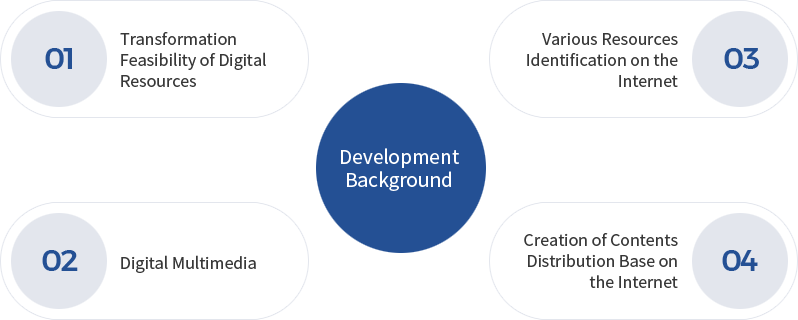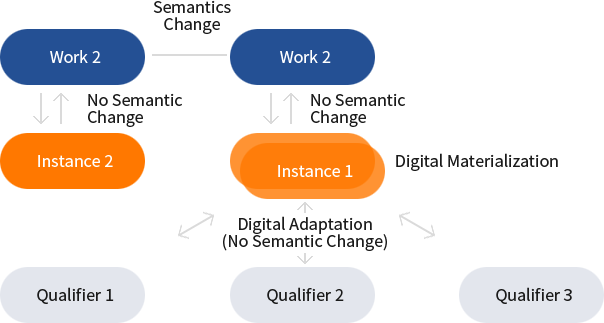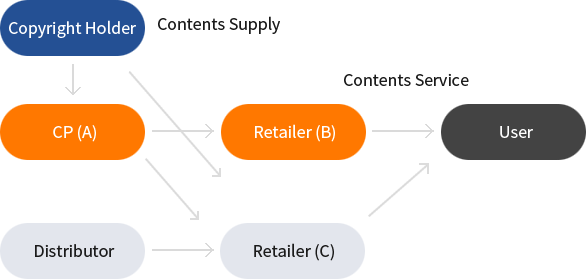Background of Development of UCI Syntax
UCI includes worldwide scope, so that no same contents with the same identifiers can exist in case that identification scope is extended by applying a unique identifier to a single content worldwide.
- 01.Transformation Feasibility of Digital Resources
- 02.Digital Multimedia
- 03.Various Resources Identification on the Internet
- 04.Creation of Contents Distribution Base on the Internet
Characteristics of UCI Syntax
Observation of functional encoding features defined in the RFC1737 of ETF
- Global scope, global uniqueness, target extendibility, perpetuity, legacy support and independence
- Single encoding, simple comparison, Human legibility, transmission friendliness, machine consumption, text recognition
Reflection of correlation with operation procedure
- A prefix code is connected with management structure of the identification scheme and the structure to register contents.
- An instance code has high dependency on the naming policy of digital contents and the applied area of the UCI identification scheme.
- widely used in the reference connection. Therefore, the qualifier is connected to the policy in relation to use convenience.
Support of standard distribution environment
Simultaneous support of on and offline identification schemes
Minimization and simplification of syntax
Syntax Development Model
Syntax Development Model
A work means thoughts of an author or a creator that have yet to be realized. UCI identification scheme provides code targeting digital realization of a work, that is, digital instance. Other various changes can exist in relation to these instances, and these changes are defined as qualifier.
Contents Distribution Model
Digital contents have a distribution structure in which digital contents are provided from the contents providing group, such as copyright holders, content providers (CP) and distributors, to retailers, and users use the contents through the retailers. The contents distribution model has a structure modeling real distribution structure in consideration of a case that retailers supply contents and a case that retailers play a role of gateway, if the copyright holders, CPs and distributors have close relations, in addition to basic contents distribution model.
Contents Management Model
- Organization Model
This model takes a mode to provide the rights of registration agency by agency. Business models can be freely developed targeting the possessed or managed contents by an organization, and the framework with guaranteed interoperability can be utilized.

Hierarchical Organization Model
This model is appropriate when different organizations manage contents together where they represent the contents of certain genre or share a clear common business purpose. This model mainly targets the organizations with features of association. A sub registration agency can be set up in this model.

- Hub Model: Hub model is the most typical UCI utilization model. This is the mode to be operated by registration authority and firms along with CPs in order to unfold various businesses based on UCI scheme. This model is mainly used by commercial organizations.
- Region Model: In this model, the rights of a registration agency are endowed regionally, and also unique regional base of a registration agency is provided. A sub registration agency can be freely chosen and managed under rules set by the registration authority within the competent realm. This aims to provide supervisory attribute rights by selecting registration agencies by region other than Korea, and a sub registration agency can be set up.
UCI Identification Scheme Structure
Configuration of Identification Scheme
The prefix code is related to resolution and contents registration structure, and the instance code and qualifier are the codes provided to contents themselves. The instance code and qualifier are called contents code together, and the prefix code is essential, but the qualifier is optional.
- Prefix Code: This is to provide for management of the digital contents to be registered. This code is to indicate management scheme by providing the information of concerned registration agency that manage the concerned contents and information of registrants and to utilize UCI as information to resolve into URL.
- Instance Code: A code to be provided to contents by a registrant in order to identify contents. When special purpose is involved, in many cases, it consists of semantic code, and otherwise it consists of meaningless code. This depends on the will of the registrant.
- Qualifier: This is the structure devised to support formative change, not semantic change of digital content
Definition of UCI Syntax
prefix = 1*(alphaDigit) *1":"1*(alphaDigit))
*1("+" 1*(alphaDigit))
instance = 1*(trans/"%" HEXDIG HEXDIG)
qualifier = head 1*(alphaDigit) *2("-" head 1*(alphaDigit))
trans = alpha Digit/ other
alphaDigit= ALPHA! DIGIT
head = "C"/"R"/"F"
other = "("/")"/"+"/","7":"/","/"="/"@"/
","/"$"/"_"/"!"/"*"/""
reserved = "%"|""|"?"|"#
NOTICE : For details of syntax, see UCI Specifications in the data room









